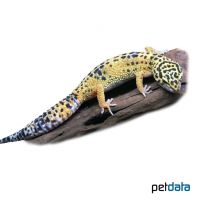Leopard Gecko Love-Blue (Eublepharis macularius)
| Leopard Gecko Love-Blue Eublepharis macularius | |
|---|---|
| Name | Leopard Gecko Love-Blue |
| Name Lat. | Eublepharis macularius |
| Family | Eublepharid Geckos |
| Family lat. | Eublepharidae |
| Order | Scaled Reptiles |
| Order lat. | Squamata |
| Origin | Asia |
| Habitat | Semi-desert |
| Diet | Insects |
| Humidity | 45-60 % |
| Behavior | Nocturnal, ♂ territorial |
| Keeping | Individual, pair, harem |
| Care Level | Easy |
| Reproduction | Oviparous |
| Housing | Dry terrarium |
| Life Span | 15-20 years |
| Protection | No |
| Metric Units | |
| Size | 25 cm |
| Temperature | 25-30 °C |
| Temperature Local | 30-35 °C |
| Housing Size | 80 x 60 x 40 cm |
| US Units | |
| Size | 10" |
| Temperature | 77-86 °F |
| Temperature Local | 86-95 °F |
| Housing Size | 30" x 25" x 15" |
Distribution and habitat
The Love-Blue Leopard Gecko is a breeding form. The crepuscular to nocturnal leopard gecko wild form inhabits the dry steppe and grasslands of eastern and southern Afghanistan, Pakistan and northwestern India, where they live mostly in burrows or under large rocks.
Maintenance
Minimum dimensions for the terrarium, according to the size and number of animals
| 1-2 animals | 4KRL x 3KRL x 2KRL (L x W x H) |
Head-torso length (KRL) is measured on the largest animal. For each additional animal, increase the footprint by 15%. A terrarium of e.g. 80 x 60 x 40 cm is recommended, which should be placed in a quiet and vibration-free place
You need a strongly structured terrarium with roots and flat stones (controllable hiding places and visual protection), a graveable substrate of coarse sand (3-10 cm deep), a shallow water bowl and resistant potted plants (e.g. succulents, opuntias). A small part of the substrate, especially the lower sand layers, should always be kept moist. Once a day, preferably in the evening, the inside of the terrarium should be finely sprayed with water (humidity), but not directly the animals (risk of shock).
| Temp. day: 28-30 °C | Temp. night: 18-20 °C | Temp. local: up to 35 °C | Humidity: 45-60 |
Thermostatically controlled floor heating is recommended. Lighting duration must be 12-14 hrs. Daylight fluorescent tubes are ideal. For crepuscular and nocturnal animals a special UV light is not necessary.
Diet
The food supply consists of live insects, such as crickets, house crickets, grasshoppers, millipedes, zophobas and mealybug larvae. Alternatively, special ready-made food for insectivorous reptiles can be offered, possibly with tweezers for habituation. Wax moths should only be fed in small amounts to adults, but not to juveniles, because of their large fat content. Regular addition of minerals and vitamins (dusting of food) is important. Young animals should be offered food daily, adult animals 4-5 times a week. Drinking water must always be available
A varied diet promotes health and prevents deficiency symptoms.
Reproduction and breeding
The adult male has a thickened caudal root with a distinct hemipenis pouch.
The female buries her eggs (1-2 pieces) in the substrate, which must accordingly consist of a substrate suitable for burrowing. The incubation period is 40-70 days at a temperature of 28-32 °C. Small insects such as fruit flies and micro crickets are suitable as initial food for the young.
Important
Leopard geckos are bred in numerous color forms
Smaller reptiles, including their own young, are considered prey. Adult males behave territorially and incompatibility can occur among themselves. They can be well maintained in a small group, 1 male with 2-3 females.
For the resting phase, shorten the lighting time by 2-3 hours and lower the temperature by 3-4 °C for about two months, depending on the origin of the animals.
With fruit and honey water as food for the feeders, their quality can be upgraded.
The terrarium must have good ventilation without drafts and meet the species specific needs. Measuring devices such as thermometers, hygrometers, etc. are necessary. The lighting has to correspond to the species-specific day-night rhythm and has to be placed in such a way that the animals cannot injure themselves. The terrarium should be locked in such a way that neither unauthorized persons can open it nor the animals can escape. Contamination must be removed regularly.
Further literature can be found in your pet store.
References
Text: petdata; Image: petdata
Source: BMELV (1997): Tierschutzgutachten - Mindestanforderungen an die Haltung von Reptilien; ENGELMANN (2006): Zootierhaltung - Tiere in menschlicher Obhut: Reptilien und Amphibien, Harri Deutsch Verlag
- Gemäß § 21 Abs. 5 Tierschutzgesetz idgF
